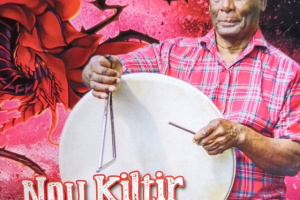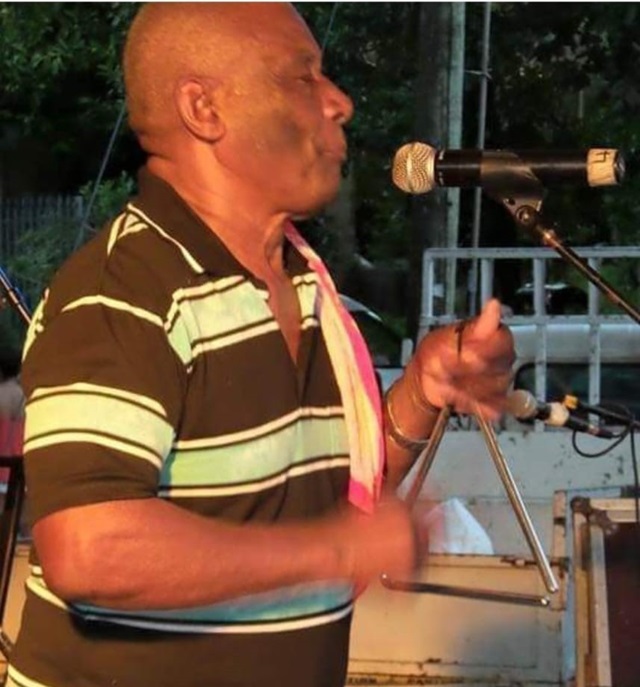Seychelles bids farewell to Moutya master Norville Ernesta
Obituaries |Author: Sharon Ernesta | February 17, 2024, Saturday @ 13:20| 35944 views
Ernesta was a man who had played a pivotal role in promoting and keeping the Moutya music and dance alive. (Paul Ernesta)
(Seychelles News Agency) - Three years after the Seychelles Moutya dance was formally recognised by the United Nations Educational, Scientific and Cultural Organisation (UNESCO) as a world intangible cultural heritage, the island nation bids farewell to Norville Ernesta, a man who had played a pivotal role in promoting and keeping the Moutya music and dance alive.
Ernesta, aged 75, who passed away last week on Friday, February 2, was buried on Saturday. His funeral service was held at the Immaculate Conception Cathedral in Victoria on the main island of Mahe.
He was known for his performances and albums of solely Moutya music and dance, passed away due to illness. His latest production was a CD titled "Our Culture," released in 2019.
Ernesta's contribution towards Moutya was not only by promoting the music and dance but he played a pivotal role contributing to the dossier prepared for submission to UNESCO when Seychelles was lobbying for this recognition.
Julienne Barra, who worked on the dossier, said Ernesta had a wealth of knowledge about the Moutya, which was brought to the islands by African slaves.
 |
| He was known for his performances and albums of solely Moutya music and dance. (Paul Ernesta) Photo License: All Rights Reserved |
"But I started to develop a relationship with him when he launched his group "Fek Arive". He was one artist who provided us with a lot of information for the UNESCO dossier. So, he played his part to get the Moutya recognised," Barra told SNA.
He added that "Ernesta was an artist whom I can say gave Moutya music and dance a revival and popularity, a modern taste to Moutya. He in a way gave Moutya a new found fame. What made him stand apart from other artists was that he took a risk and produced a whole album of Moutya."
Nigel Henrie, a renowned Seychellois painter, told SNA that he is saddened by the passing of Ernesta, someone who was so passionate about our traditional music and the Moutya, "at a time when there was silence around Moutya, he persevered, he made his CDs along with his group, he brought the Moutya music and dance to many touristic establishments, giving visitors to our islands a chance to experience the Moutya."
"I salute Norville as I firmly believe he was key to Seychelles' Moutya being designated as a world cultural heritage," said Henrie, adding that Ernesta was proud and stayed loyal to his cultural roots.
Henrie said that Seychelles must give due recognition to such artists, "For Norville, let us start by documenting and archiving his work. And why not dedicate a corner in the National Library to these artists, the likes of Pay, Francois Havelock, Ton Pa and others who are still alive such as David Philoe, Joseph Louise and John Wirtz."
Married to Inese for 50 years, Ernesta had five children. One son passed away a few years ago. Inese recounted that ever since she met him in the early 1970's he was playing the guitar in a band and that the love for music was passed to Ernesta by his older brother Laurence.
Inese told SNA that she is heartbroken over the passing of her husband, who was very caring and was all for his family and home. "He had a big heart, when my sister passed away, he helped raise her kids, and did the same for another family member," she said.
 |
| Ernsta with his family. (Paul Ernesta) Photo License: All Rights Reserved |
Apart from his passion for the island nation's traditional music and dance, Ernesta loved Creole cuisine and his favourite dish to cook was octopus curry with coconut milk.
Ernesta's legacy will live on as he had transferred his love and talent for traditional music to the younger generation – his grandchildren – all members of his band, gifted and who can both play instruments and sing.
According to Ernesta's son Paul, as a family, they will decide how the band will be managed so as to ensure that the family continues what the patriarch had started.
When he launched his eighth album in 2019, the late Norville Ernesta said "Moutya is our culture, when you talk about Seychellois culture the first thing that comes to mind is moutya and this is why my album is titled 'Nou Kiltir' ['Our Culture']. My inspiration is Seychelles, our culture and our way of life. Back in my younger days, Moutya was popular but it is slowly becoming less popular, especially with the younger generation."
Ernesta pointed out at the time that young musicians should embrace the culture instead of feeding into "mainstream music" that has taken over the local music industry.
Elvis Seraphine, a three-decade music collaborator of the Moutya master, told SNA how they journeyed 30 years together creating, producing, singing and giving the Moutya its due value and importance. Along the way the two shared a great friendship at the same time creating beautiful memories.
"What will stay with me was the modern twist we put to the song 'Madeleine,' which came out in 2006, how popular it was and still is until today, in total over 5000 CDS were sold," said Seraphine.
He added that what stayed with him was how disciplined Ernesta was when it came to his performances. "He was truly talented and could spontaneously create a new song, which would come out well and fit perfectly with the music."
The Moutya dance was introduced to the Seychelles, an archipelago in the western Indian Ocean, by enslaved Africans who arrived there with French settlers in the early eighteenth century. It was originally performed around a bonfire, deep in the forest in the dead of night. The dance was an expression of resistance, allowing enslaved people to share their suffering and sing about the difficulties they faced, far from their masters' ears.
Back
